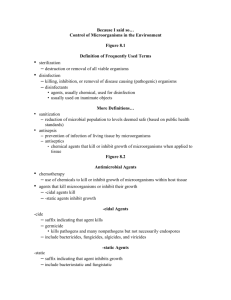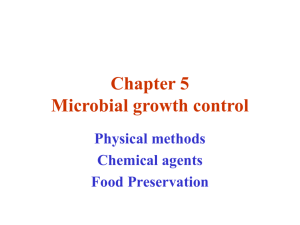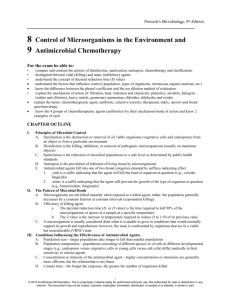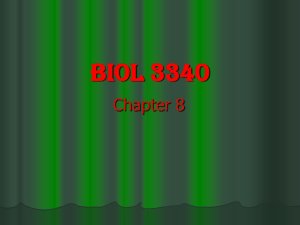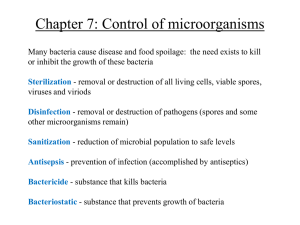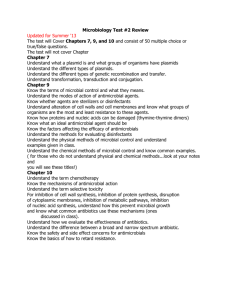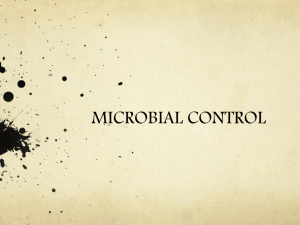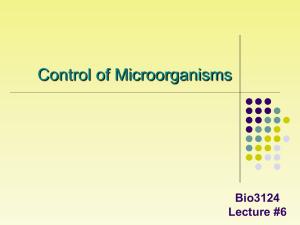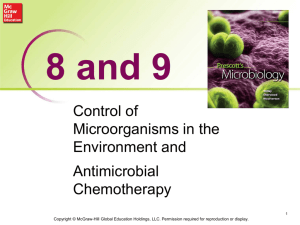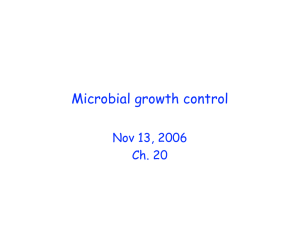Control of Microorganisms by Physical and Chemical Agents
advertisement
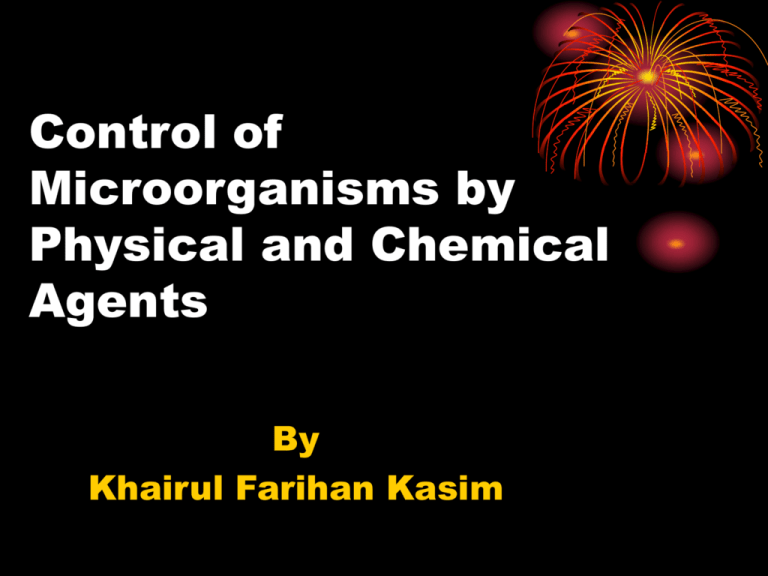
Control of Microorganisms by Physical and Chemical Agents By Khairul Farihan Kasim CO3: Ability to define, describe and utilize microbial growth in fermentation and biological process At the end of the chapter, the student should be able to: • compare and contrast the processes of disinfection, sanitization, antisepsis, and sterilization • compare the difficulties encountered when trying to kill endospores with those encountered when trying to kill vegetative cells • discuss the exponential pattern of microbial death • discuss the influence of conditions (population size, composition, concentration or intensity of antimicrobial agent, duration of exposure, temperature, local environment) influencing the effectiveness of various agents used to control microbial populations • discuss the uses and limitations of various physical and chemical agents used to control microbial populations • describe the procedures (phenol coefficient test and use dilution test) used to evaluate the effectiveness of various antimicrobial agents Definition of Frequently Used Terms • sterilization • destruction or removal of all viable organisms • disinfection • killing, inhibition, or removal of pathogenic organisms • disinfectants • agents, usually chemical, used for disinfection • usually used on inanimate objects • sanitization • reduction of microbial population to levels deemed safe (based on public health standards) • antisepsis • prevention of infection of living tissue by microorganisms • antiseptics • chemical agents that kill or inhibit growth of microorganisms when applied to tissue Concept check Distinguish between sterilizer, a disinfectant, a sanitizer and an antiseptic Antimicrobial agents • agents that kill microorganisms or inhibit their growth • -cidal agents kill • -static agents inhibit growth • -lytic agents lysis -cidal agents • -cide • suffix indicating that agent kills • germicide • kills pathogens and many nonpathogens but not necessarily endospores • include bactericides, fungicides, algicides, and viricides -static agents • -static • suffix indicating that agent inhibits growth • include bacteriostatic and fungistatic -lytic agents • -lytic • • • • • • Induce killing by cell lysis Observed as a decrease in cell number In turbidity after the agent is added Antibiotic that inhibit cell wall synthesis Penicillin Chemicals like detergents that rupture the cytoplasmic membrane Measuring antimicrobial activity • Determining the smallest amount of agent needed to inhibit the growth of a test organism Minimum inhibitory concentration (MIC) • Lowest concentration of agent that completely inhibits the growth of the test organism • Tube dilution technique Agar diffusion • Zone of inhibition • Diameter proportional to the amount of antimicrobial agent added • The solubility of the agent • The diffusion coefficient • Overall effectiveness of the agent Concept check • With regard to antibacterial agents, distinguish between static, cidal and lytic agents. • Describe how the MIC of an antibacterial agent is determined. The Pattern of Microbial Death • microorganisms are not killed instantly • population death usually occurs exponentially • microorganisms were previously considered to be dead when they did not reproduce in conditions that normally supported their reproduction • however we now know that organisms can be in a viable but nonculturable (VBNC) condition • once they recover they may regain the ability to reproduce and cause infection Conditions Influencing the Effectiveness of Antimicrobial Agent Activity • population size • larger populations take longer to kill than smaller populations • population composition • microorganisms differ markedly in their sensitivity to antimicrobial agents • concentration or intensity of an antimicrobial agent • usually higher concentrations or intensities kill more rapidly • relationship is not linear • duration of exposure • longer exposure more organisms killed • temperature • higher temperatures usually increase amount of killing • local environment • many factors (e.g., pH, viscosity and concentration of organic matter) can profoundly impact effectiveness • organisms in biofilms are physiologically altered and less susceptible to many antimicrobial agents The Use of Physical Methods in Control • • • • heat low temperatures filtration radiation Moist Heat Sterilization • must be carried out above 100°C which requires saturated steam under pressure • carried out using an autoclave • effective against all types of microorganisms including spores • degrades nucleic acids, denatures proteins, and disrupts membranes The Autoclave or Steam Sterilizer Pasteurization • controlled heating at temperatures well below boiling • used for milk, beer and other beverages • process does not sterilize but does kill pathogens present and slow spoilage by reducing the total load of organisms present Dry Heat Sterilization • less effective than moist heat sterilization, requiring higher temperatures and longer exposure times • items subjected to 160-170°C for 2 to 3 hours • oxidizes cell constituents and denatures proteins Dry Heat Incineration • bench top incinerators are used to sterilize inoculating loops used in microbiology laboratories Measuring Heat-Killing Efficiency • thermal death time (TDT) • shortest time needed to kill all microorganisms in a suspension at a specific temperature and under defined conditions • decimal reduction time (D or D value) • time required to kill 90% of microorganisms or spores in a sample at a specific temperature • Z value • increase in temperature required to reduce D by 1/10 Low Temperatures • freezing • stops microbial reproduction due to lack of liquid water • some microorganisms killed by ice crystal disruption of cell membranes • refrigeration • slows microbial growth and reproduction Filtration • reduces microbial population or sterilizes solutions of heatsensitive materials by removing microorganisms • also used to reduce microbial populations in air Filtering liquids • depth filters • thick fibrous or granular filters that remove microorganisms by physical screening, entrapment, and/or adsorption • membrane filters • porous membranes with defined pore sizes that remove microorganisms primarily by physical screening Filtering air • surgical masks • cotton plugs on culture vessels • high-efficiency particulate air (HEPA) filters • used in laminar flow biological safety cabinets Ultraviolet (UV) Radiation • limited to surface sterilization because it does not penetrate glass, dirt films, water, and other substances • has been used for water treatment Ionizing Radiation • penetrates deep into objects • destroys bacterial endospores; not always effective against viruses • used for sterilization and pasteurization of antibiotics, hormones, sutures, plastic disposable supplies, and food Chemical Control Agents Disinfectants and Antiseptics Phenolics Phenolics • commonly used as laboratory and hospital disinfectants • act by denaturing proteins and disrupting cell membranes • tuberculocidal, effective in presence of organic material, and long lasting • disagreeable odor and can cause skin irritation Alcohols • bactericidal, fungicidal, but not sporicidal • inactivate some viruses • denature proteins and possibly dissolve membrane lipids Concept check • Explain why 70% ethanol is more effective than 100% ethanol for sterilization. Halogens • any of five elements: fluorine, chlorine, bromine, iodine, and astatine • iodine and chlorine are important antimicrobial agents Halogens - Iodine • skin antiseptic • oxidizes cell constituents and iodinates proteins • at high concentrations may kill spores • skin damage, staining, and allergies can be a problem • iodophore • iodine complexed with organic carrier Halogens - Chlorine • oxidizes cell constituents • important in disinfection of water supplies and swimming pools, used in dairy and food industries, effective household disinfectant • destroys vegetative bacteria and fungi, but not spores • can react with organic matter to form carcinogenic compounds Heavy Metals • e.g., ions of mercury, silver, arsenic, zinc, and copper • effective but usually toxic • combine with and inactivate proteins; may also precipitate proteins Quaternary Ammonium Compounds Quaternary Ammonium Compounds • detergents that have antimicrobial activity and are effective disinfectants • organic molecules with hydrophilic and hydrophobic ends • act as wetting agents and emulsifiers • cationic detergents are effective disinfectants • kill most bacteria, but not Mycobacterium tuberculosis or endospores • safe and easy to use, but inactivated by hard water and soap Aldehydes • highly reactive molecules • sporicidal and can be used as chemical sterilants • combine with and inactivate nucleic acids and proteins Effects of Glutaraldehyde Sterilizing Gases • used to sterilize heat-sensitive materials • microbicidal and sporicidal • combine with and inactivate proteins Chemotherapeutic Agents • chemicals that can be used internally to kill or inhibit the growth of microbes within host cells • their selective toxicity allows them to target the microbe without harming the host • most are antibiotics, chemicals synthesized by microbes that are effective in controlling the growth of bacteria Evaluation of Antimicrobial Agent Effectiveness • complex process regulated by US federal agencies • Environmental Protection Agency • Food and Drug Administration Phenol coefficient test • potency of a disinfectant is compared to that of phenol Other evaluation methods • use dilution test • determines rate at which selected bacteria are destroyed by various chemical agents • in-use testing • testing done using conditions that approximate normal use of disinfectant
